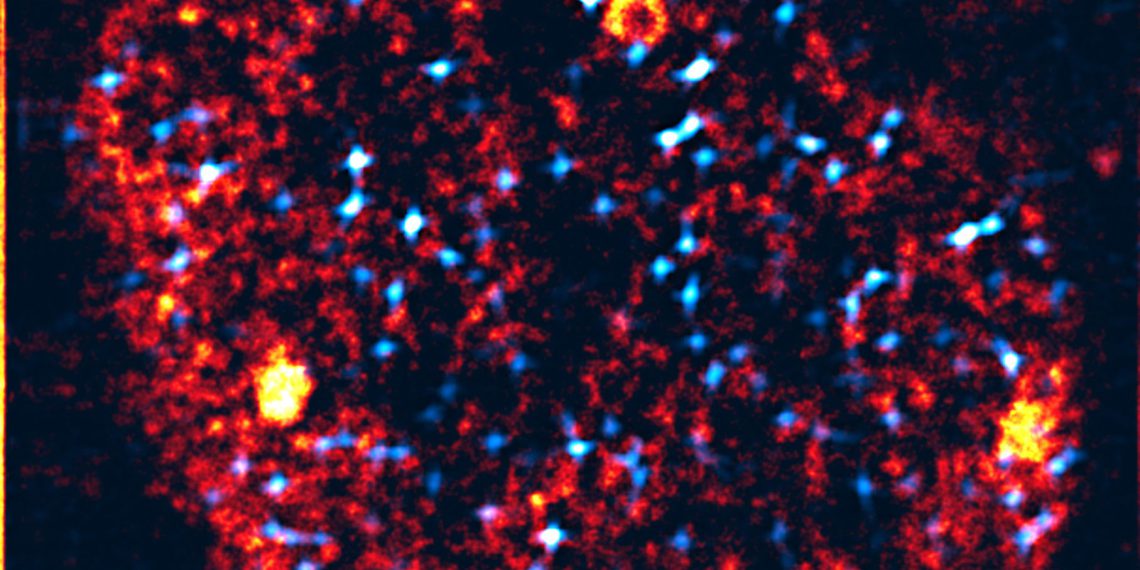Cells must precisely control which of the many genes contained in the genome they use. This is done in so-called transcription factories, molecular assemblies in the cell nucleus. Researchers at the Karlsruhe Institute of Technology (KIT), at the Friedrich Alexander University Erlangen-Nuremberg (FAU) and at the Max Planck Center for Physics and Medicine (MPZPM) have now found that the formation of transcription factories resembles the condensation of liquids. Their findings may contribute to the understanding of disease causes in the future, as well as advance the development of DNA-based data storage. The researchers report in Molecular Systems Biology.
The human genome contains more than 20,000 different genes. However, each cell accesses only a fraction of the information stored in this genome. Cells must therefore precisely control which genes they use — otherwise, for example, cancer may develop or embryonic growth may be disturbed. A central role in the selection of active genes is played by so-called transcription factories.
“These factories are molecular assemblies in the cell nucleus that combine the correct selection of active genes and the readout of their sequence at a central location.”
- Lennart Hilbert, assistant professor
Set up and running in a matter of seconds
How transcription factories are built and specifically started up within a few seconds has occupied cell and molecular biologists for decades. Results from recent years indicate the relevance of processes that were previously only known from industrial and technical polymer and liquid materials. Currently, research is particularly investigating phase separation as a central mechanism. In everyday life, phase separation is evident, for example, in the separation of oil and water. Until now, however, it was not clear how exactly phase separation contributes to the construction of transcription factories in living cells.
Researchers at the Institute of Biological and Chemical Systems (IBCS), the Zoological Institute (ZOO), the Institute of Applied Physics (APH), and the Institute of Nanotechnology (INT) of KIT, together with scientists at the Friedrich Alexander University Erlangen-Nuremberg (FAU), the Max Planck Center for Physics and Medicine (MPZPM) in Erlangen, and the University of Illinois at Urbana-Champaign/USA, have gained new insights into the formation of transcription factories: It happens in a similar way to the condensation of liquids. The scientists show this in a publication in the journal Molecular Systems Biology. First authors are Agnieszka Pancholi from KIT’s IBCS-BIP and ZOO, and Tim Klingberg from FAU and MPZPM.
State-of-the-art light microscopy combined with computer simulations
In their publication, the researchers show that condensation during the formation of transcription factories is similar to fogging up a pair of glasses or a window pane: Liquid only condenses in the presence of a receptive surface, but then very rapidly. In the living cell, specially marked areas of the genome serve as condensation surfaces. The fluid-coated areas allow the attachment of relevant gene sequences as well as additional molecules that eventually activate the attached genes.
These findings were achieved through an interdisciplinary collaboration. For example, the researchers observed zebrafish embryos with state-of-the-art light microscopes developed in Professor Gerd Ulrich Nienhaus’ team at APH. These observations were combined with computer simulations at the Department of Mathematics in the Life Sciences at FAU and at MPZPM, which is headed by Professor Vasily Zaburdaev. The combination of observations and simulations makes the condensation process comprehensible and explains how living cells can quickly and reliably build transcription factories.
In recent years, the new understanding of condensed fluids in living cells has provided fundamentally new approaches to the therapy of cancer and nervous system diseases. These approaches are already being pursued by recently formed companies to develop new drugs. Other research is looking at the use of DNA sequences as digital data storage devices.
The feasibility in principle of DNA-based data storage has now been demonstrated by several research groups. However, reliably storing and reading information in such DNA storage media is still a challenge. “Our research shows how the biological cell organizes such processes quickly and reliably at the same time.

















